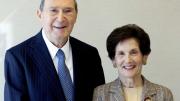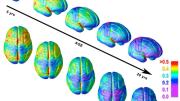On October 18, Harvard announced that benefactors Rita E. Hauser, L ’58, and Gustave M. Hauser, J.D. ’53, had donated $40 million to encourage pedagogical innovation and strengthen learning and teaching throughout the University. Their gift focuses attention on one of the institution’s chief academic missions and illustrates the scale of the philanthropy the University aims to muster as it pursues its twenty-first-century agenda in a forthcoming capital campaign. During the next decade, the funds will support a new Harvard Initiative for Learning and Teaching (HILT), encompassing activities from underwriting faculty- and student-initiated innovations, to reorganizing classrooms, to building expertise in evaluating the effectiveness of teaching techniques.
The gift itself, President Drew Faust said, resulted from the Hausers’ response to a planning paper exploring capital-campaign priorities. In the news announcement, Gustave Hauser referred to “a whole generation of new students who require new teaching and learning methods,” and noted that HILT “focuses Harvard’s enormous resources on making higher education more effective.” Added Rita Hauser, “This is really a start-up, if you like, and we hope it will be a catalytic gift…not just for Harvard, but for universities in general.”
In a conversation at her Massachusetts Hall office, Faust said teaching and learning will be “front and center in the campaign,” because they are “at the heart of who we are and what we do.” The time is right, she added, because this is a moment of “transformation” driven by increased knowledge about how people learn and by technological changes that enable new applications of that knowledge. Improved education is a priority “Harvard has been investing in increasingly”—not just financially, but “pragmatically, institutionally, and emotionally”: witness the Faculty of Arts and Sciences’ Compact on Teaching and Learning adopted in 2007; the Kennedy School’s SLATE (Strengthening Learning and Teaching Excellence) program—with its distinctive emphasis on assessing rigorously what students get from a course; and the Business School’s “very self-conscious approach to teaching.”
There are also external reasons for making this a priority, she said. The public increasingly questions how higher-education institutions can enhance learning if they aren’t sure what is working. Hence the initiative’s emphasis on experimentation coupled with evaluation. For all the emphasis on research within research universities, Faust concluded, that mission necessarily includes dissemination of discoveries—through publication, inventions and applications, and, of course, teaching.
The Hausers’ gift provides flexible funding, to be applied where the president discerns particularly promising opportunities; it is not an endowment, but a major infusion of resources meant to affect how Harvard fulfills its educational mission in the near term—and to seed further investments that support continuous classroom improvements.
A working group of faculty members and deans has been tackling these issues as part of the preliminary brainstorming for a capital campaign. One participant was Eric Mazur—Balkanski professor of physics and applied physics and dean for applied physics in the School of Engineering and Applied Sciences (SEAS)—who is widely known for pioneering quick-response mechanisms (initially using “clickers” but now including wireless devices) to assess how well students grasp and can use new concepts; he is now focused on small groups and student-led interactive learning. Faust cited him for “reconceiving how conceptual learning takes place.”
Mazur is an evangelist for much more sweeping change who in conversation said he was “delighted that Harvard is finally, seriously paying attention to teaching.” More broadly, he said, “99 percent of teaching spaces” were anticipated thousands of years ago—for instance, in the Greek amphitheater: rows or rings of seats meant to “focus the attention of the many on the one” (a teacher or performer). But education, he said, is not about transferring information; it is about learning within the student. With information now ubiquitous and readily available, the classroom ought to focus on assimilation and application of knowledge to new contexts. The teacher, he said, “becomes the guide on the side, instead of the sage on the stage,” requiring wholly new learning spaces, teaching techniques—and an entirely different way to teach future teaching professionals. “We have a long way to go,” Mazur said, “which is why I’m so happy about this gift.”
John G. Palfrey VII, Ess librarian at the Law School and professor of law, a scholar of all things digital, also participated in the planning group. He said universities “haven’t figured out how fundamental a change digitization will be,” and that assessing the efficacy of educational innovations and outcomes was rudimentary, at best. He characterized as “very exciting” the prospect of “venture-capital-style investing” in teaching innovations, alongside spending to move toward classroom spaces “that will connect to digital environments, that are flexible.” (Palfrey is leaving Harvard to become head of Phillips Academy, Andover, on July 1.)
Although HILT’s aims are bound up in experimentation, innovation, and discovery—with outcomes unknown—some initial courses of action have been defined.
- Innovation grants. Faculty, deans, administrators, postdoctoral instructors, and students are eligible to apply for grants to pursue educational innovations, from “developing instructional methods, tools, and assignments” to “integrat[ing] pedagogical scholarship into pedagogical practice” or “incorporat[ing] technology and social media into teaching and learning activities.” Grants will be issued by February 3 (coinciding with the University-wide HILT pedagogical conference).
- A launch conference. A conference on February 3 with Harvard and outside experts will introduce the best current thinking on the science of learning (based on studies of cognition, active learning, and so on) and innovations in higher education. There will also be demonstrations of diverse pedagogies, and of new ideas in teaching, data collection, and analysis.
- Infrastructure. Contemporary teaching is more technologically based, more visual, often highly experiential, and increasingly international (sometimes in real time). Accordingly, the initiative will support experimental configurations of classrooms around campus, and pay to fit them out.
- Evaluation. How do faculty members know whether their teaching, or changes in their teaching, work? The realm of inquiry that Faust described as “thinking about assessment in different ways—how we evaluate students, faculty, methods, and courses and programs” is crucial if a broad push for innovation is to yield meaningful findings and application of fruitful discoveries. A nucleus for doing this work has been created within the office of the president and provost: a newly hired director of assessment and evaluation will work with professors and others to devise questions, advise on data, and perform the analyses to see whether, say, students who attend class perform better than those who take in lectures via online recording.
As innovation grants yield new teaching ideas, classroom infrastructure is rebuilt, and evaluation proceeds, administrators promise, the direction and scope of HILT’s activity will also expand and change.








